|
Dr. Subrata Roy Assistant Professor Department of Commerce Rabindra Mahavidyalaya (Affiliated to the University of Burdwan),Champadanga, Hooghly, West Bengal, India Email: subrata1_roy@yahoo.com |
Day by day, buying patterns of the consumers’ are changing, it is not because of market structure but also invention and application of technology and their usability. The roles of the marketers are not playing the game against the will of the consumers’ but to facilitate them in an extreme way. In this context online marketing play a huge role for fulfilling the need and demands of the present consumers’. Consumers are also getting benefit and they are also giving feedback in terms of review and rating about the products or services through online and which relay helps the marketers for development of strategic decision. The preset paper the researched try to find out the impact of online review on buying behavior / intention of the consumers’ in India. The analysis has been done on secondary database provided by Datafiniti's Product Database. The list has over 71,045 reviews from 1,000 different products. Sentiments analysis indicates that there are some factors like joy, trust and anticipation are most important factors raised from consumers and high level of intensity being observed with some specific products like movies, personal care etc. it is a new dimension of the marketers to assess the consumer trends towards their offering specially in entertainment and personal care product. Study also highlights that when the length of review is longer, then the chance of having a positive recommendation goes down (Predictive Modeling). The correlation diagram indicates when people write lengthy reviews they will definitely not recommend. Present paper will help the marketers to judge the market condition and also analyze the consumer mind. This can help them to design more customized products.
Key words: Consumer satisfaction, product review, ratings, sentiment analysis, predictive model.
Present market run as a buyer market and the role of marketers is to supply the right information to the industry. Industries make correction on the basis of feedback given by the consumers. If we look into the market trend, the modern market is inclined on digital technology. Modern consumers’ prefer to do a lot of purchasing activities through digital platform. Using the digital platform consumers give their feedback in terms of review or rating about the products or brands. Markets have considered response from digital platform an important parameter of customer satisfaction. Multiple factors of satisfaction are considered for academic purpose like quality of the products, price index, supply process, transaction system, CRM process, packaging and post purchase review by the company. As consumers give their open comments about the product, marketers’ try to make a projection on the comments and understand the behavioral pattern of the consumers’ and their level of satisfaction. In consumer behavior, the Elaboration Likelihood Model suggests that identifying the impact of variables on the motivation is necessary. But the model is not sufficient for predicting the effects of arguments presented in a message. Managers and researchers try to identify consumer motivation. The ability to process the message will help to predict the effects of messages on attitudes. According to the above mentioned model consumer follow two route of persuasion namely central and peripheral route. The process of information processing has a huge role in predicting the behavior of the consumers’. The two main types of reviews in online platforms are expert-written reviews and customer-written reviews. Expert-written reviews refer to those written by expert reviewers often hired by popular e-commerce vendors or portals [Amblee, Bui 2007] whereas customer-written reviews typically refer to those posted by buyers turned consumers who have used or experienced a focal product [Schindler& Bickart, 2012]. Psychologists and behavior researchers argue that the source of information significantly influences the customers’ attitude toward the information. Experts and customers typically play different roles in the transmission of different signals to consumers [Chaiken 1980, Petty & Cacippo, 1986]. Other than the important role of review source, review content can also influence consumers because they typically learn about products from what the reviewers said [Zhu et al 2010] Consumers today are largely comfortable with reading online reviews when considering a purchase. They learnt to spot fake reviews, and many of them leverage multiple online sources before making a decision. When laying out hard-earned cash for an online purchase, it seems that consumers will rely more on the quality, and availability of reviews provide that timely insight. Occasionally shoppers may reach out on social media fraternity to members of their networks. But physical contact although provide the instant feedback it require time for them to make their purchase. It’s for this reason online product reviews is so critical for sellers. Trust plays a deciding factor whether or not to make a purchase online. Viewers rely on the volume and consistency of reviews to help us paint a mental picture of the brand. Although getting firsthand information from people we actually know and would allow us to apply our perception. Recommendation helps to make a decision based on the sum of that information (Neil Parker, Online Product Reviews: Trust is More Important Than Ever, http://sumo.ly/VK8S via @rewardstream 26-10-2015).
Product Reviews help marketers with branding, marketing and evaluate the advertising strategy of the Ecommerce store as well as the product in question. With the right push at the correct angle, an Ecommerce store can very easily advertise its prospects in the market via the customer feedbacks. For instance a product that has a number of good reviews on a certain Ecommerce store raises general user interest. The raised level of interest leads consumers to talk more about the product among themselves.Even when users meet in personal group meetings they talk about products reviews which had received rave reviews thereby directly or indirectly advertising and marketing the product. This is the reason why brands like Samsung, Levis, etc. have gained a huge market in a very short time. It is to be noted that companies cannot compromise on quality of the products they sell. Positive Product Reviews help establish a favorable image of the product which actually persists long after the product has already been launched. Also, for the serious marketer, Product Reviews are a great way to interact with the consumer directly and know the details of their product through the eyes of the consumer and make developments wherever necessary. With proper follow up of Product Reviews, the seller can accurately know the loopholes of itsown products and the areas in which it can improve its product to meet the needs of the end consumer. This leads to a positive experience among the consumer which ultimately helps the business in the future.(Importance of Product Reviews in Ecommerce, https://www.appseconnect.com/importance-of-product-reviews-in-ecommerce) Keser (2002) documented that the presence of a feedback mechanism significantly increases the levels of trust and trustworthiness. Information provided by sellersis perceived less trustworthy to buyers. This is because the perceived notion is that seller will focus on good aspects of a product and will lack or will not disclose information on inferior aspects. In General buyers rely more on consumer created information, compared to seller created information. Seller created information is product orientated and objective, focusing mainly on product attributes (Park et al., 2007). Bonabeau (2004) states that people imitate others, not only to be accepted, but also to be safe. Prospective buyers generally do believe that other consumers have better information on the product, because they have already bought and used it. The reviews provide usage situations, advantages and feedback from people. Consumer reviews have a dual role, they inform and recommend. Reviews help to identify buyers with consumers. On one hand it provides user generated information about the product; on the other hand it provides recommendations by users in the form of electronic word of mouth. Petty and Cacioppo (1984) did research on the effect of strong and weak arguments on the purchase decision of people with low and high involvement. High involvement products are products for which consumers are prepared to spend more time and effort in searching for the right one. Low involvement products are products that consumers buy more frequently and will take less time to search. For high involvement products quality is more important. When looking at the search process of high involvement products, it can be compared with the search process of experience goods. Experience goods have attributes that cannot be acquired before purchase or use and for those attributes information search is more costly or difficult. Consumers are willing to do long and difficult research for a product, when it is an experience good. This is the same for high involvement products. Because the information search for high involvement products and experience goods looks alike, it could be true that quality is more important for experience goods (compared to search goods) as well. To find out if this influence of review quality on Consumers' online purchase decision (COPD) really is stronger for experience goods, the following hypothesis is tested. According to Huang and Chen (2006) consumers are influenced in their online purchase decision by the number of positive vis- à-vis negative consumer reviews. When the quantity of positive reviews is sufficiently large, they can overcome the negative attitudes of negative reviews and have a positive influence on COPD. Park et al. (2007) and Petty and Cacioppo (1984) showed that the effect of review quantity on purchase decision is stronger for consumers with low expertise than for those with high expertise. Observing consumers in general, Petty and Cacioppo (1984) and Chen and Xie (2008) stated that the number of reviews can be a signal of the popularity of a product and the number of reviews is related to an increase in the amount of product information. It is very likely that the number of reviews will lead to risk reduction for consumers, because many others have bought the product as well. Purchase intention increases when review quantity increases, so in this case, purchase intention will be positively influenced by review quantity.
In present era, information can be spread in different modes. Consumers’ generally follow the most interactive media like digital and social media. They prefer to give their feedback about the product over online platform. The important task of marketers is to analyze the consumer response for development of product and market. In this regards present study will analyze the trend of consumer response about their product or services. Hence we will try to answer two research questions from our study
1) How consumer perception has changed over the years for different categories of product? 2) Does the review pattern have any impact on review rating? 3) How likely are the customers ready to recommend their purchased product?
The list has over 71,045 reviews from 1,000 different products.The dataset includes the text and title of the review, the name and manufacturer of the product, reviewer metadata, and more.Data have been collected based on following fields where we have tried to assess how writing quality impacts positive and negative online product reviews. 1) Id 2) Brand 3) categories 4) date added 5) date updated 6) manufacturer name 7) manufacturer id 8) review’s date 9) review’s date added 10) review’s date seen 11) review’s did purchase 12) review’s do recommend 13) review id 14) review’s source 15) review’s rating 16) review’s text 17) review’s title 18) review’s user city 19) review’s user name 20) review number Upon further analysis of the data the following questions can also be answered. This paper had attempted to answer the following questions.
• Do reviewers use punctuation correctly? • Does the number of spelling errors differ by rating? • What is the distribution of star ratings across products? • How does review length differ by rating? • How long is the typical review? • What is the frequency of words with spelling errors by rating? • What is the number of reviews that don’t end sentences with punctuation? • What is the proportion of reviews with spelling errors?
Basic exploratory analysis ran on the data for correlation between different observations. We predominantly ran sentiment analysis on the data and tried to associate sentiment with product categories over a time period.Word-cloud was formed to find the most significant words. To further narrow our search we identified list of users who have at least posted 20 reviews and categorized which product received maximum reviews. Finding correlation between reviews, length of reviews and given ratings is the core of this paper. To further our research we have conducted predictive analysis to predict ratings given by users based on their purchase behavior. We ran logistic regression model to find the accuracy of our model. We have also identified individual weights given to each independent variable to predict the outcome.
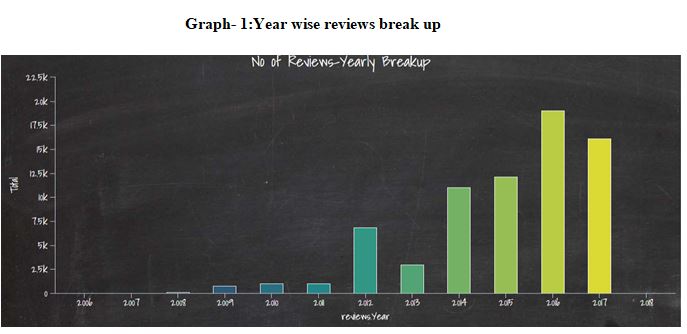
The above data analyze the review trend of last 10 year. Graph indicates that people are engaging themselves in giving review about the products and brands. The graph clearly point out that the number of reviews increased in the year 2016.But the trend of posting reviews reduced after year 2016. It may be that consumers are following buying process for same product time and again. It can be stated that marketers should showcase product in digital space for getting more exposure which in turn may develop product and brand loyalty. Online marketing can help marketer to segment their product and place their product for better market coverage.
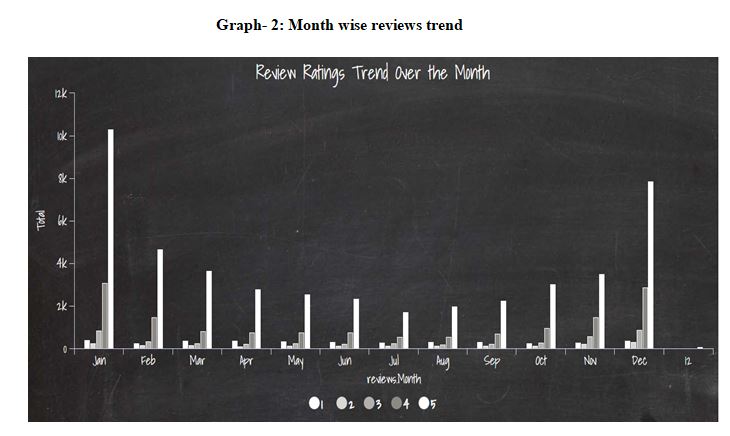
The above graphical representation indicates that the review rate is more in the month of December, January and February in comparison to other months of the year. This trend has been observed over a period 10 years. During winter in India people’s purchase intentions are generally high in area of personal care, household care and movies tickets. It is a good hint for brands to campaign relevant product in these months and offer more design. Graph 2 calls for development of the diversification strategy for the new customers in Indian market.Weather plays a crucial role in the choice for consumer’s channel of purchases.One study found that on wet or cold days there was a 12% increase in website traffic for retailers in the home & furniture, wholesale, and clothing verticals - compared to that on warm and sunny days.(weather ads 2014, http://www.weatherads.io/blog/2014/june/how-weather-affects-consumer-behaviour-and-purchase-decisions. Quite simply, user reviews increase conversions. They can eliminate any doubts potential customers may have about a product, or can help product selection.
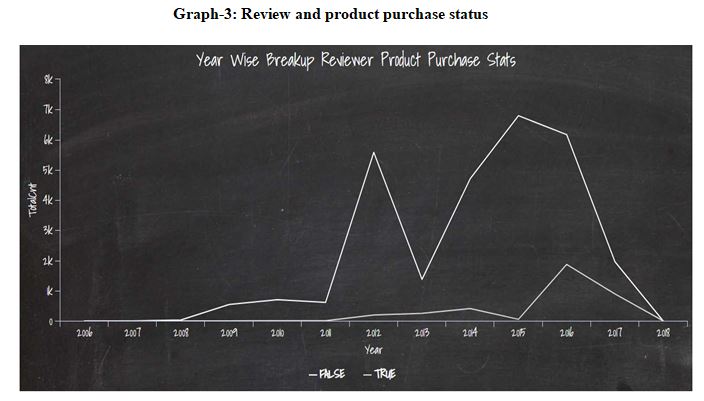
Graph 3 represent the cycle between product review and purchase. The graph shows that after year 2011 the number of reviews went up. Following year the purchase graph increases except year 2016 when reviews and purchase have shown a positive relation. Therefore we can correlate that people as more and more people are sharing their views online it got translated into purchasing process. The reviews not only act as a tool of communication but also aid real purchase. Marketers’ challenges are design of product preview in a manner which may work in a positive way, i.e. to boost the process of purchasing process of consumers. The other assumption from above graph indicates that people purchase the product from other sources but giving an online review about their positive or negative response, which may help marketer to design more customer centric market strategy.
Category wise |
Count |
Total reviews |
Category wise |
Percentage |
Movies |
63/ 290 |
1700 |
564 |
33 |
Personal care |
32/290 |
1700 |
347 |
20 |
Household essentials |
33/290 |
1700 |
268 |
16 |
Featured brand |
36/290 |
1700 |
188 |
11 |
Food & beverage |
41/290 |
1700 |
106 |
6 |
In the present study we have analyzed the review pattern for different product category/ type. There are total 290 unique reviewers considered (who have given more than 20 reviews in a year) with different product category. Total 1700 reviews have been considered in between 2014-2017. If we look into the product category, it is seen that movies have given highest percentage of review i.e. 33 percent. It indicates higher trend in reviews for movies and movie shows. Reviews observed in the personal care and household essential category are for 20 and 16 percent respectively. If we examine Table 1 results, it shows that online review trend is increasing not because of the product category, but because people start trusting online reviews more than ever. The data is supported by graph 4.
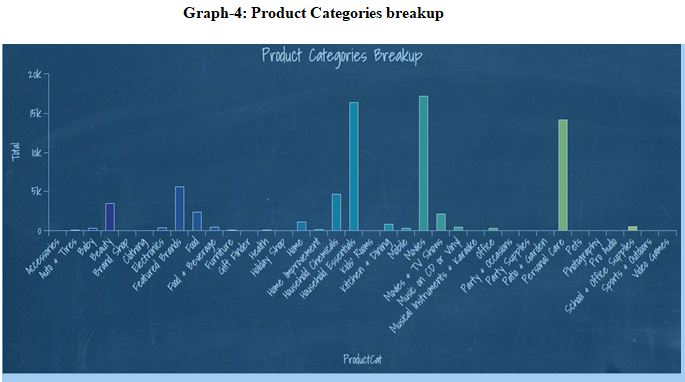
We also ran a word cloud on our 1700 reviews and found out that movies are the most prominent product on which consumers have opinionated. The word cloud does also demonstrate which words customers do use to express their satisfaction for a product. Diagram 1 portrays the word-cloud of those 1700 chosen reviews for our study. Words below have following frequency 1.great - 14368 2.movie - 108743.good- 59184. the – 5917 5. love – 5488 6. product– 54527. for -4297.
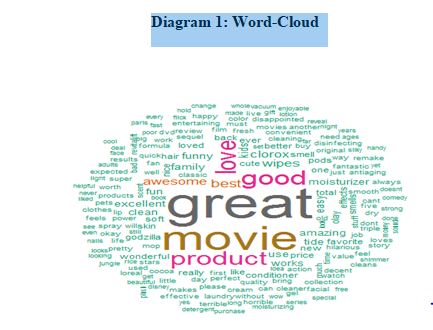
Online ordering is highly dependent on customer sentiments. If customer can emotionally connect with a brand or product then the number of positive reviews and recommendation do increase. We ran sentiment analysis on our data set and classified human emotions in eight distinct categories namely anger, anticipation, disgust, fear, joy, trust, sadness and surprise.
It is quite evident that although the overwhelming sentiment is of joy, it is going down year after year. Sadness is on an upward swing. This trend needs to be investigated further with product category to identify the trend and come up with a solution.
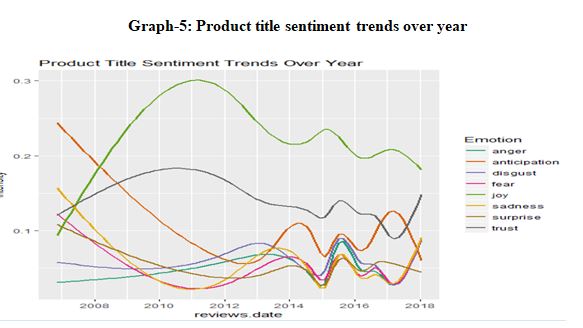
We ran sentiment analysis using Natural language Processing algorithm on the actual review and categorized by review rating. It is quite evident that when people give 1 Star they are either very angry or demonstrate disgust. According to the graph disgust is the most prevalent feeling among all shortly followed by anger. But the surprising aspect of the graph is trust factor. Post 2016 the trust factor has seen a sharp spike. Let’s look at the individual product category to identify why the trust factor goes up and in year 2014 the level of anger and disgust at the lowest.
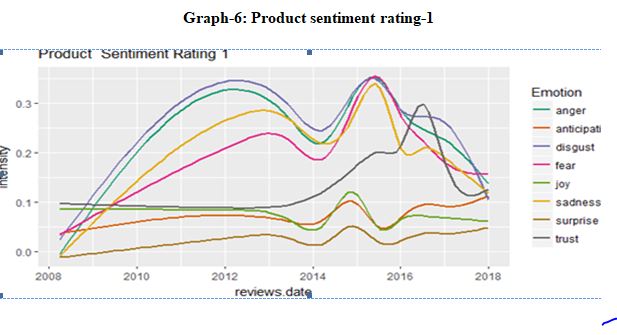
In year 2014 Household product primarily has received lowest rating. As household products is something which do not bother a consumer much w.r.t. quality, the level of anger and disgust have gone down. Whereas when the product is related to personal care emotions are pretty high thereby leading to extreme condition like either high on trust and sadness. Year 2015 onwards emotions runs high in favor of personal care. Data for year 2017 showed that products those featured with the lowest rating are predominantly household care, movies category. The reason maybe that customers are not satisfied and are getting more exposure towards the online buying and thereby giving online rating of product. Therefore it is a vital task of the market researcher is to constantly look into the market trend to take care about their demonstration of the product or brand.
As expected when the rating is high the Joy is the predominant feeling. In spite of that joy and trust is progressively decreasing.
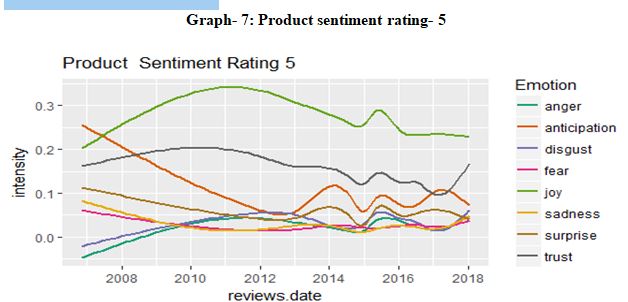
Analyzing further it has been found that 5 star rating was initially for household items but as time progress movies stated getting more 5 star rating than anything else and the fan favorite from 2014 i.e. household items were not anything close to the movies. This clearly explains the loss of trust and joy as movies are momentary but personal care and household items are more close to personal sentiments. Therefore market has to develop more structural market substance for the household and personal care product for which the feeling within the customer mind should enhance. Because the growth of the online business are increasing in the Indian market, if we go through the market share point of view than personal care and household care has a big market coverage. But the high rating shows the entertainment industry and the inner meaning is than young mass target specific. In this connection, I market can convert the young mass from movies to other product than it will be good sign for market growth and development
Now let’s analyze the correlation between parameters like Did the customer purchase the item ,did they recommend and what bearing do ratings and length do have on repeat purchase and recommendation. If customers purchase an item there is a weak positive correlation that they are likely to recommend as the value comes to 0 .07. But the relation is pretty strong when the rating is high. It is also but normal when customer is dissatisfied they will write lengthy reviews and will not recommend nor will purchase. The strength of relation is negatively strongest with recommendation. This means when people write lengthy reviews they will definitely not recommend.
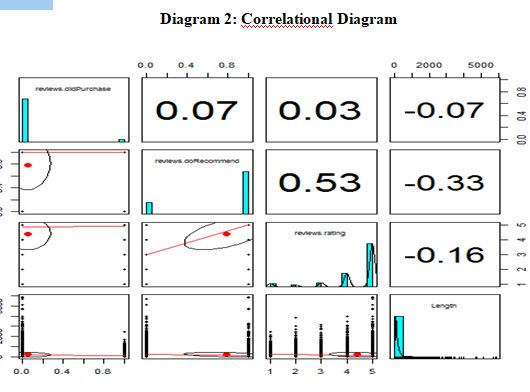
In the model we tried to predict if the customer is going to recommend other for the product based on variable like 1) Has the reviewer purchased the item 2) What is the length of the Survey 3) What is the kind of rating has the customer has given to the product We ran Logistics regression on our model and got the following results
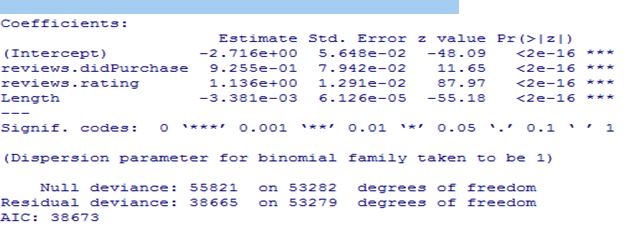
Misclassification Accuracy – 86% The results shows that whether a reviewer purchased a product or not and the kind of rating it has provided has a direct effect on whether the reviewer will recommend the product or not. But when the length of review is longer, then the chance of having a positive recommendation goes down. The AIC value shows that the model is a moderate fit and will fit the data even when there are covariates in the model. The misclassification accuracy tells that out of 100 the model will correctly predict recommendation 86 times. This assumption is also supported by AUC curve which shows that a large part of the area is under curve the number of positive assumption is more.
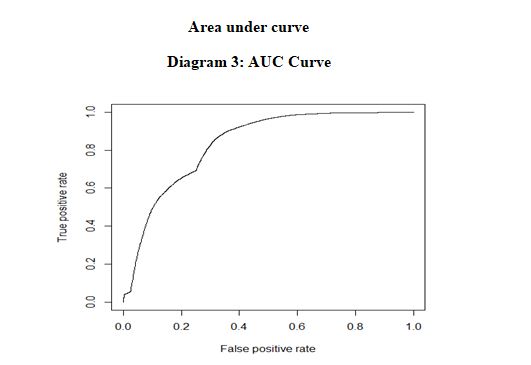
The present study is an attempt taken by the researchers to assess the consumer perception and preference by looking into the tendency of their online review and ratings of the products. From the analysis, it indicates that trends towards online reviews are increasing and higher trend observed in the month of December, January and February. As per product category is concerned, Movies, personal care and household essentials gave a significant identification in term of product review (report based on collected data). The research finds a growth potential between review and purchase behavior, the tendency increases year wise. Sentiments analysis indicates that there are some factors like joy, trust and anticipation are most important factors raised from consumers and high level of intensity being observed with some specific products like movies, personal care etc. it is a new dimension of the marketers to assess the consumer trends towards their offering specially in entertainment and personal care product. Study also highlights that when the length of review is longer, then the chance of having a positive recommendation goes down (Predictive Modeling). The correlation diagram indicates when people write lengthy reviews they will definitely not recommend. Present paper will help the marketers to judge the market condition and also analyze the consumer mind. This can help them to design more customized products.
Amblee, N. and Bui, T. Freeware downloads: An empirical investigation into the impact of expert and user review on demand for digital goods. In 13th Amercias Conference on Information Systems, Colorado, USA, 2007. Bonabeau, E. (2004). The Perils of the Imitation Age. Harvard Business Review, June. Chaiken, S. Heuristic versus systematic information processing and the use of source versus message cues in persuasion. Journal of Personality and Social Psychology, 39, 5 (1980), 752-766. Chatterjee, P. (2001). Online Reviews: Do Consumers Use Them? Advances in Consumer Research. Vol. 28, 129-133. Chen, Y., and Xie, J. (2008). Online Consumer Review: Word-of-Mouth as a New Element of Marketing Communication Mix. Management Science, Vol. 54, No. 3, March, 477-491. Huang and Chen (2006),Herding in online product choice, Psychology & Marketing, vol 23, issue 5, pp 413-428. Keser, C. (2002). Trust and Reputation Building in e-Commerce. IBM Research Report, July. Neil Parker, Online Product Reviews: Trust is More Important Than Ever http://sumo.ly/VK8S via @ reward stream retrieve on 26-10-2015. Park et al (2007), The Effect of On-Line Consumer Reviews on Consumer Purchasing Intention: The Moderating Role of Involvement, International Journal of Electronic Commerce, Vol 11, issue 4.pp 125-148. Petty, R.E. and Cacioppo, J.T.(1986) The elaboration likelihood model of persuasion. Advances in Experimental Social Psychology, 19, 1, 123-205. Petty, R.E., and Cacioppo, J.T. (1984). The Effects of Involvement on Responses to Argument Quantity and Quality: Central and Peripheral Routes to Persuasion. Journal of Personality and Social Psychology, Vol. 46, No. 1, 69-81. Schindler, R.M. and Bickart, B.(2012) Perceived helpfulness of online consumer reviews: The role of message content and style. Journal of Consumer Behavior, 11, 3, 234-243 Zhu, L.; Benbasat, I., and Jiang, Z. Let's shop online together: An empirical investigation of collaborative online shopping support. Information Systems Research, 21, 4 (2010), 872-891.